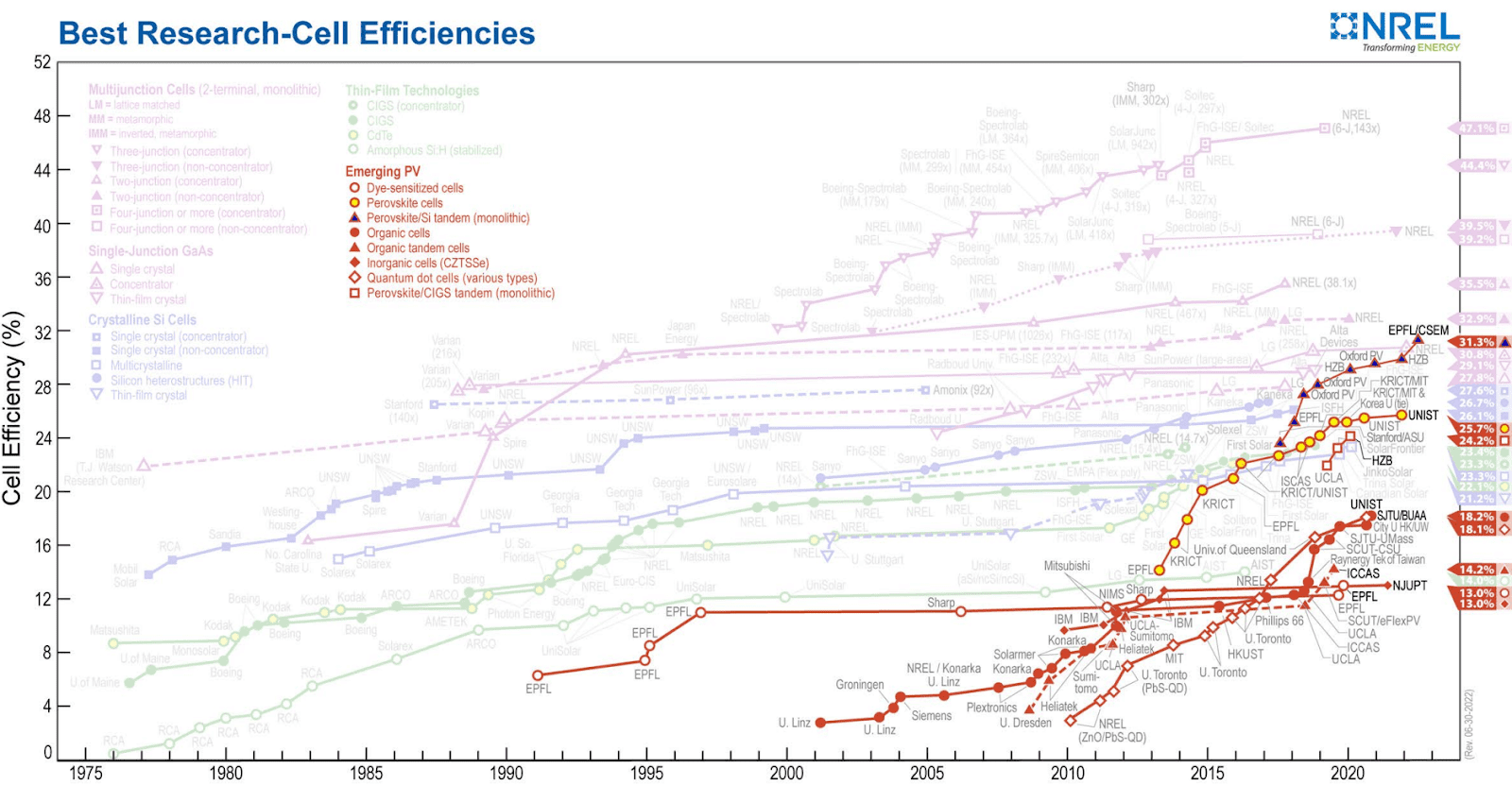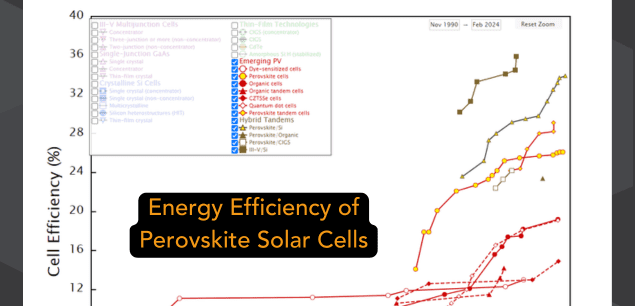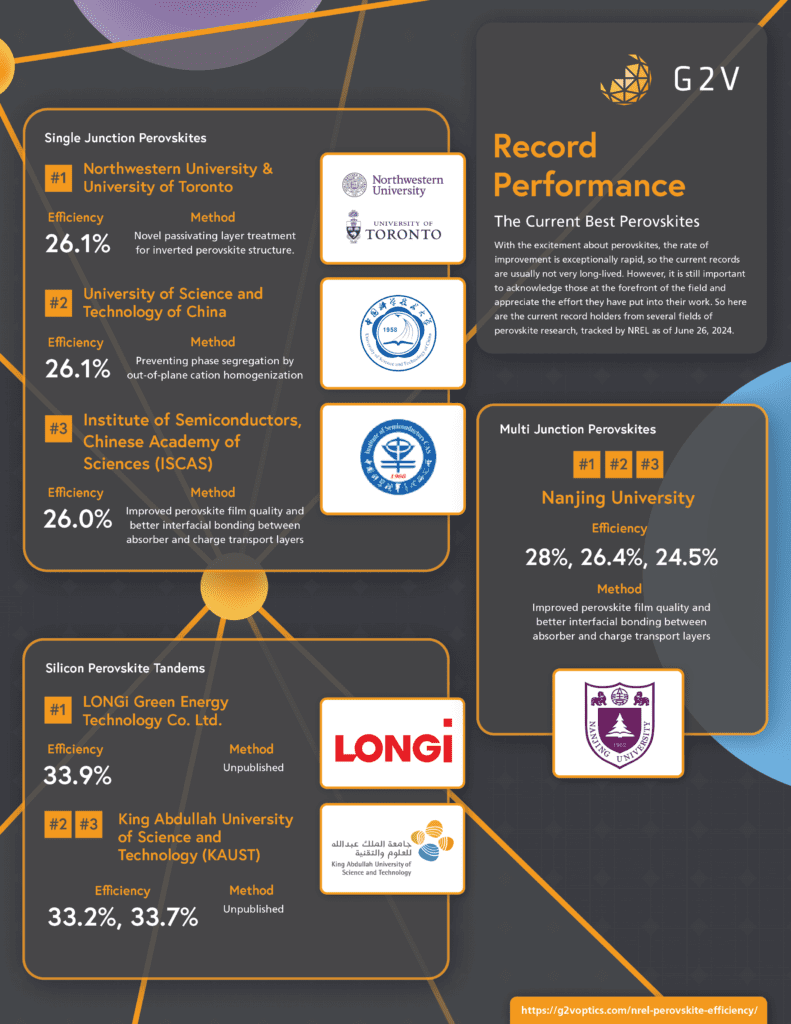Chapter 7
Energy Efficiency of Perovskite Solar Cells
With all perovskite benefits (such as high absorption coefficient, high relative permittivity, and shiftable band gap) and barriers (such as UV sensitivity, high defect density, and thermal instability) that have been discussed, how do we know whether perovskites can achieve their potential for industry-leading power conversion efficiencies without requiring energy-intensive fabrication? And is there a reputable and comprehensive source for comparison against other solar cell technologies?
Thankfully, such a source does exist. The National Renewable Energy Laboratory provides detailed information on perovskite energy efficiency as well as many other metrics.
National Renewable Energy Laboratory (NREL): Current Records For State-Of-The-Art Perovskite Solar Cells
Enter the National Renewable Energy Laboratory, more commonly known as NREL, operating in conjunction with the Solar Energy Technologies Office (SETO) of the US Department of Energy. Among NREL’s many functions, they offer certified solar cell testing and publish a chart of world record holders for all solar energy technologies.

NREL’s database shows what solar cell technologies are leading the pack, how quickly some are improving their positions, and which are struggling to build upon past successes.
Note the path that perovskites have taken since they were first recognized as a distinct technology by NREL in 2011. With an initial efficiency of 14% to the latest value in 2022 of 25.7%, as seen in the above image, perovskites have shown one of the most consistently rapid rises in the efficiency of any solar technology since NREL began this archive.
Thanks to the NREL database it is easy to look through the recent and current record holders and find their publications about what makes their cells achieve the results they do.
We have collected the current leaders for the three main categories of perovskite solar technologies and the focus of the research that allowed them to achieve those records: pure perovskite solar cells, perovskite/CIGS tandem cells and perovskite/c-Si cells.
If we sort institutions according to the number of times their cells appeared in the top 3 most efficient solar cells of each category, we produce the following ranking:
- Helmholtz-Zentrum Berlin (HZB)
- Ulsan National Institute for Science and Technology (UNIST)
- École polytechnique fédérale de Lausanne (EPFL)
- Centre Suisse d’Electronique et de Microtechnique (CSEM)
- Korean Research Institute for Chemical Technology (KRICT)
- Massachusetts Institute of Technology (MIT)
- University of California, Los Angeles (UCLA)
- Nanjing University
NREL Perovskite Record Holders
Arranging these record holders into their respective fields with the topics of their research, some commonalities begin to appear.
|
Pure Perovskite cells |
Perovskite/CIGS tandem cells |
Perovskite/c-Si tandem cells |
|||||
|
Institute |
UNIST |
Institute |
HZB |
Institute |
EPFL/CSEM |
||
|
Date |
2021-12-03 |
Date |
2020-01-01 |
Date |
2022-06-17 |
||
|
Efficiency |
25.7% |
Efficiency |
24.2% |
Efficiency |
31.3% |
||
|
Surface and bulk defect mitigation through anion passivation |
Improved quality of interface layer and alkali metal doping of PSC and CIGS layers |
Hybrid vapour/solution processing on textured silicon surface |
|||||
|
Institute |
KRICT/MIT |
Institute |
HZB |
Institute |
HZB |
||
|
Date |
2019-07-01 |
Date |
2019-06-01 |
Date |
2021-11-16 |
||
|
Efficiency |
25.2% |
Efficiency |
23.3% |
Efficiency |
29.8% |
||
|
Charge carrier management through improved SnO2 ETL fabrication and separated passivation steps for surface and bulk defects |
Self Assembled Monolayers for electrode junctions to improve conductivity and reduce surface defects |
Textured interface and dielectric back reflector |
|||||
|
Institute |
Nanjing University |
Institute |
UCLA |
Institute |
HZB |
||
|
Date |
2019-12-01 |
Date |
2018-11-17 |
Date |
2020-01-01 |
||
|
Efficiency |
24.2% |
Efficiency |
22.4% |
Efficiency |
|||
|
Antioxidant additives for passivating surface defects in all perovskite tandem cells |
Highly doped hole transport junction layer between subcells |
Fast hole extraction via self assembled monolayer interface between PSC and Si subcells |
|||||
The current record holder in single-layer perovskite cells, UNIST, focused their efforts on improving the electrical connection between the photo-absorber perovskite layer and the charge transport layers. They succeeded via the design of a special interlayer coating of formamidinium tin chloride perovskite to prevent the formation of the normal density of defects between the layers that interrupt charge flow and lower efficiency.
And it’s not just pure perovskite solar cells that are showcasing exciting growth and ability. Related combined multijunction technologies of Perovskite/CIGS (PS/C) cells and Perovskite/Silicon (PS/Si) also show impressive capability and potential, with PS/Si cells showing a confirmed 31.25% power conversion efficiency.
Looking across all the three types of perovskite cells denoted above it is also possible to see common themes of research in these record holders.
The most obvious is the focus of all these projects on improving the quality of charge conduction between layers of the devices themselves. Whether that is a junction between the PSC layer and the Si or CIGS layer or simply the interface between the intrinsic perovskite layer and the CTL, this seems to be the most important variable to control and improve upon.
Once surface defects (such as the interfaces between different materials) have been sufficiently mitigated, there then arises the consideration of how to passivate the other remaining defects. We see the investigation of other defect mitigation in the research from both the KRICT/UCLA teams and UNIST, as they strive to maximize the performance of pure perovskite devices.
The final area of focus for perovskite solar cell record-holding research is the exploration of the benefits of doping the active materials in the cells. The record-holding HZB research in the fields of PSC/CIGS tandem cells used such a technique which could be a chief strategy to consider and monitor in the years to come.
All of these considerations are topics that have been explored above as known barriers to higher-performance perovskite cells, and seeing the work that these institutions have done to address them is a source of excitement for all those who have high hopes for the promises of perovskites as a powerful tool in the decarbonization toolbox.
Combine this showcased progress with some of the recent improvements in other areas of perovskite research such as ferroelectric inorganic perovskites, rapid-aging testing procedures, incorporation of advanced 2D materials, and advanced manufacturing processes such as vapour-phase or electrodeposition, it is exciting to think about what the cell efficiency chart will showcase for perovskites in the coming years.
A natural question after seeing such rapid technology development is, how does a researcher test a perovskite solar cell’s performance, their potential faults, and if a new strategy has corrected them? We’ll discuss how researchers are testing and validating perovskite technologies next.
Next Chapter 8: How Are Researchers Testing And Validating Perovskite Solar Cells In Their Labs?
Looking for a cheat sheet with all of the key concepts in this article? Check out the one-page infographic below.

